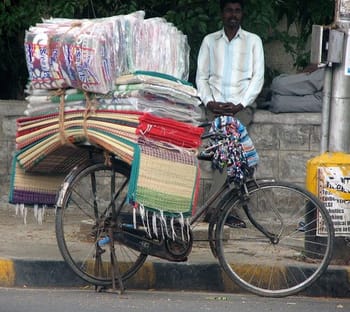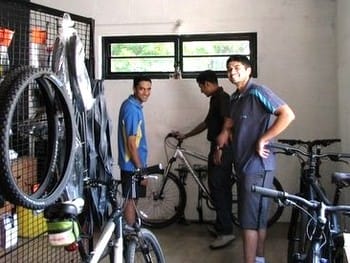One of the modes of transport which has been prevalent in many Indian cities has been cycling; and recently, it’s been much touted as a non-polluting, eco-friendly, fitness-building activity, which is an exercise as well as a means of getting from A to B.
Cycling within this city has many has many participants, from the toddlers on their first bikes, to hobby cyclists, to those who cycle because of their commitment to non-pollution, to those who cycle because that is the means of transport most affordable to them. Here are a few vignettes from each sector:
Many children often begin their young days with the gift of a cycle from their parents; it’s obviously, a very pleasant activity for the child, and a cycle is a treat, a gift to be looked forward to. Where, typically, would young children cycle?

Children’s cycles in an apartment corridor (pic: Deepa Mohan)
"If we have houses," says Manju Narasimhiah, of Jayanagar, "and we have large pavements like we have here, there is no problem at all in letting the children cycle on them. We don’t have to let the children get on the road or in the traffic, and we are not worried about them, even though a couple of adults from a few of the houses would be around to keep an eye on all of them." She smiles as her little son, Aditya, age 7, sails past her, ringing his cycle bell for all he is worth.
What about people who live in apartment buildings? Here, too, there doesn’t seem to be much of a problem. "Our children cycle in the common areas," says Mr Viswanath, president of an apartment building in south Bangalore. However, some problems arise when the cycling children have to share the pathways with the cars of the residents; the priority, of course, goes to the motorists. Children, and their parents, are advised to be careful.
This attitude of motorists-take-priority-over-cyclists spills over into all road spaces, too. Non-motorised transport like cycles or pushcarts are always viewed, not as eco-friendly transport, but as a nuisance and an impediment.
Part of this also has to do with the fact that the cycle is one of the least expensive modes of transport, and hence is used by the least economically-abled sector. And hence it has very negative associations in the minds of both users and non-users.
As far as non-users’ attitudes go, one only has to look at the scant respect with which cyclists are treated in traffic and at traffic signals to experience first hand the scorn and abuse which is often heaped on a cyclist who is desperately pedalling up a slope. The cars, vans, buses and other motorised traffic that the cyclist might be blocking for a while are quite vocal in their sentiments!
Cycle users, too, cannot be blamed, then, for aspiring to "higher" and motorised forms of transport. It is definitely a hard slog up some of the slopes of Bangalore roads, and it is no fun pedalling for all one is worth in the hot summer sun, or the pouring monsoon rain. Therefore, as soon as they are able to afford it, cycle users want to buy a moped or a motorbike, which will cut down on their travelling time and physical effort.
"I want to get a moped as soon as I can," emphasises Mari Gowda, who delivers newspapers on a cycle at present." It will help me deliver the papers faster, and I will hear lesser complaints from my customers about late deliveries." And, he adds, he will be able to get to his part-time classes on time, too.
In spite of this, though, cycles are quite often put use as mobile business venues. Which of us has not seen a cycle with a circular basket loaded with fresh fruits, or flowers, wending its way along the residential roads? Sometimes these cycles, loaded with wares, are parked at some road junctions, allowing the cyclist to sell his goods to passersby.

Cycle with mats for sale (pic: Deepa Mohan)
For many school-going youngsters, too, cycles remain a very popular mode of transport. I saw several children in my area biking back from school; one little fellow, going home from his school in the IIM Bangalore campus, smiled at me and said, "I cycle along the trees on the campus, it’s nice!" (None of the cyclists of this category that I saw ever wore helmets; it’s an alien concept to them.)
Cycles are also able to negotiate traffic very differently from four-wheelers. The little machines have the convenience of being wheeled down one-way roads, carried over road barriers, and taking short-cuts that four-wheelers cannot take. This is probably why they are quite a menace to rule-abiding traffic, too! A cycle going the wrong way down a one-way street causes no less a traffic accident than a four-wheeler doing the same thing…but most often, the traffic police do not enforce one-ways strictly for cycles, and turn a blind eye to cyclists breaking traffic rules.

Cycling to school, inside IIMB (pic: Deepa Mohan)
Another part of the cycling spectrum comprises the hobby-cyclists…these are the people who have a generous disposable income, and would like to do something about their waistlines and flab, and decide that cycling would be the ideal solution. For these users, cycles are available in all price-ranges, but the "coolest" bikes are those at the high end of the market rates. This is where upmarket cycle emporia come in.
I went to meet Rohan Kini and Nikhil Eldurkar, who started something entirely new in Bangalore…an online cycle store. They perceived a need for really upmarket cycles in the market, and decided to embark on the venture, which sometimes seemed foolhardy even to them! However, the timing was excellent, as Trek was coming into India at the time, and they got several cycles shipped across from China… and BumsOnTheSaddle was born.
After scouting around for a place to set up the store, they decided on constructing a structure on the terrace of Nikhil’s home. The concept of the online store was also a little different; over the week, prospective customers would contact Rohan or Nikhil over email or phone, and set up an appointment, and they would meet at the store. "Our overheads were considerably slashed because of this business model," says Rohit, smiling happily. "We did not need a full-time manager in the shop, or assistants, or security." Also, the interaction between the customers and the proprietors of the cycle store has been more on a friend-peer basis. Many of the people who buy the cycles join in on Rohan and Nikhil’s regular weekend trips to various destinations at an average distance of 60 km from Bangalore.
"We deliberately set aside business once in a while, to enjoy some weekend cycling," say this duo who walk the talk…..both of them cycle to work every day; a distance of about 11km each way for Rohan, and about 17 km each way for Nikhil. "It keeps us in great shape, too," they laugh.
Walking the talk…or, rather, cycling it…is something Rohan and Nikhil and their friends have in common with "Bikeszoners", an online group for cyclists, started by Abhijith Road in 2003. The Bikeszoners believe that cycling actually can take less time sometimes than taking a four-wheeler to work, and saves the daily haggling with autos. This group believes that cycling is not such a tough option as one thinks; and the sense of camaraderie is palpable. When one member’s cycle (an expensive Trek cycle) was stolen, the group organized a search and it was found within 24 hours!

Bums on the Saddle Store (pic: Deepa Mohan)
Bikeszoners, too, like BumsOnTheSaddle, like to do weekend expeditions along with their regular cycling to work. Shree Kumar, for example, has cycled from Mysore to Kanyakumari, from Chennai to Kolkata, and most recently, from Arunachal Pradesh to Gujarat. However, all these people cite the lack of dedicated bike-paths as a major stumbling block to cycling in Bangalore. Cycling can become a dangerous activity given the complete disdain of the motorised vehicle driver towards these two-wheelers.
This, in fact, was one of the reasons that Arun Pai who, with BSA’s support, had started a Bangalore Bicycle Ride initiative, had to give it up.
"Our walks had been very successful, so when BSA were introducing their folding bicycles (the idea being that the cycles could be folded and stored in the cars and taken out when required, at weekend getaways or rush inner-city traffic), he decided to do a cycle tour, and having been a fairly committed cyclist himself, went around mapping routes for the tour. BangaloreWalks conducted 4 of these cycling tours, all within the Cantonment area, on four consecutive Sundays.
They identified the start time as about 2.30pm in the afternoon, (the time of least traffic) and the end of the tour as 5.30pm, starting and ending in Cubbon Park, with only very easy cycling to do (Arun took all the slopes into consideration) and lots of stops on the way while Arun explained the city sights and sounds to them. Indeed, cyclists were asked to imagine that in Victorian Bangalore, they were mounting their steeds and setting off!
The four tours were very enjoyable," says Arun, "but the logistics of keeping a group of cyclists together in Bangalore traffic completely defeated us." Taking right turns, he realized was very tricky, so he had to design the tours with more left turns; and even then, at traffic signals, several cyclists got left behind. "It was a huge responsibility to take on the safety of so many people at once — we once had 18 people together." Also, disparate levels of physical fitness meant that the group could not be together all the time. Elderly people, who had cycled 20 years in the past, discovered that their calf muscles were not up to even the gentle cycling that was required.
"I also had to have a mechanic on hand, and an emergency car in case someone could not keep up and had to get back. My overheads shot up, and just on that account I could not charge the customers more," he says. Ruefully, BangaloreWalks decided to stick to walks and not to cycling.
Well, that would give the Bangalorean an idea of the various facets of cycling that Bangalore has.
And there is also the very miniscule minority of older women like me (actually, I have not seen or heard of another one, but I hope there ARE some) who like to do all their chores by cycle as far as possible, and do not have fancy Mountain Terrain Bikes, but go about happily on what I call LRT (Little Rattle Traps!) So the next time, aroundabouts Bannerghatta Road and J P Nagar, you see a lady on a little cycle loaded with small parcels, being harassed by the SUV owner to move on, give her a heartening smile, because she will probably be me! ⊕
That’s a great story! Makes me want to try huffing and puffing through heavy traffic on a cycle!
Nice to see the article. The awareness should grow. This is one of the ways to ease traffic woes in the city. Trust me on this, it is easier on the cycle in the traffic rather than any other form of transport.
Oh cool! Great to find coverage on this here! By the way, interested folks could sign up with bangalore-bikers@googlegroups.com to keep in touch for info, rides.